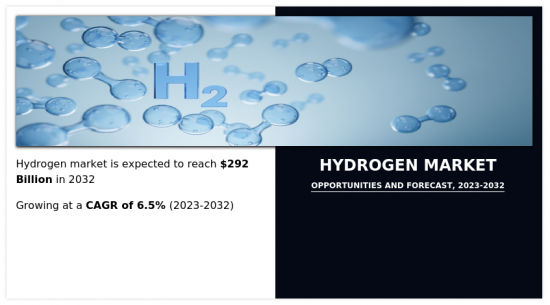
|
시장보고서
상품코드
1344342
수소 시장 : 공급 형태별, 유형별, 최종 용도별 - 세계 기회 분석 및 산업 예측(2023-2032년)Hydrogen Market By Delivery Mode (Captive, Merchant), By Type (Blue Hydrogen, Grey Hydrogen, Green Hydrogen), By End Use (Refining, Power Generation, Transportation, Food Processing, Others): Global Opportunity Analysis & Industry Forecast, 2023-2032 |
||||||
Allied Market Research가 발행한 '수소 시장' 보고서에 따르면, 수소 시장은 2022년 1,559억 달러로 평가되며 2023년부터 2032년까지 연평균 6.5% 성장하여 2032년에는 2,920억 달러에 달할 것으로 예상됩니다.

수소는 다양한 용도로 사용되며 다양한 산업에서 활용되고 있습니다. 일반적으로 발전과 수송용 연료로 사용됩니다. 연료전지에서 산소와 결합하면 수소는 수증기만 배출하면서 전기를 생산할 수 있습니다. 화학 산업에서 수소는 암모니아, 메탄올 및 기타 중요한 화합물 생산에 사용됩니다. 또한 수소는 야금, 석유 정제 및 일부 산업 공정에서 환원제로 사용됩니다.
발전용 수소 수요 증가는 향후 몇 년 동안 시장 성장을 견인할 것으로 예상됩니다. 수소는 발전의 탈탄소화에서 중요한 요소로 간주됩니다. 수소를 연료로 사용함으로써 발전소는 온실가스 배출을 크게 줄일 수 있습니다. 연료전지에서 수소를 연소하거나 사용하면 제품별로 수증기만 발생하기 때문입니다. 따라서 수소는 화석연료를 대체할 수 있는 유력한 발전 대안이 되어 기후변화를 완화하는 데 기여할 수 있습니다.
또한, 수소는 다양한 방식으로 사용할 수 있어 발전의 유연성을 제공합니다. 가스 터빈에서 직접 연소하거나 연료전지에서 고효율로 발전할 수 있습니다. 또한 수소는 열병합발전(CHP) 시스템에서 사용할 수 있으며, 발전에서 발생하는 폐열을 회수하여 난방 및 산업 공정에 사용하여 전반적인 에너지 효율을 높일 수 있습니다.
또한, 수소는 그리드 밸런싱과 에너지 저장에 중요한 역할을 할 수 있습니다. 풍력, 태양광 등 재생에너지로 생산된 잉여 전력을 이용해 전기분해를 통해 수소를 생산할 수 있습니다. 수소를 저장해두면 재생에너지 발전량이 적거나 수요가 많을 때 나중에 발전용으로 사용할 수 있습니다. 이를 통해 간헐적인 재생에너지를 전력망에 통합할 수 있어 전력 공급 안정화에 기여할 수 있습니다.
하이브리드 발전소는 '파워 투 엑스(power-to-X)' 시설이라고도 불리며, 재생에너지 발전과 수소 생산 및 활용을 결합한 것입니다. 이 시설들은 잉여 재생에너지로 수소를 생산하여 발전, 운송 및 기타 용도로 사용할 수 있습니다. 하이브리드 발전소는 재생에너지를 최대한 활용하고 서로 다른 에너지 부문 간의 공생 관계를 구축할 수 있는 방법을 제공합니다. 또한 수소를 천연가스와 혼합하여 기존 가스 터빈 및 복합화력 발전소의 연료로 사용할 수도 있습니다. 이 접근 방식을 혼합 연소라고 하며, 기존 천연가스 인프라와 발전 시스템에 수소를 점진적으로 통합할 수 있습니다. 혼합 연소는 기존 발전 자산을 활용하면서 배출량을 줄이는 데 도움이 될 수 있습니다.
목차
제1장 서론
제2장 주요 요약
제3장 시장 개요
- 시장 정의와 범위
- 주요 조사 결과
- 영향요인
- 주요 투자 기회
- Porter's Five Forces 분석
- 공급 기업의 교섭력 낮음
- 신규 참여업체의 위협이 낮다
- 대체품의 위협이 낮다
- 경쟁의 강도가 낮다
- 구매자의 교섭력이 낮다
- 시장 역학
- 성장 촉진요인
- 연료전지 전기자동차의 수소 이용 증가
- 발전의 수소 이용 증가
- 성장 억제요인
- 수소 제조에 따른 고비용
- 기회
- 청정에너지 수요 증가
- 성장 촉진요인
- COVID-19에 의한 시장에 대한 영향 분석
- 주요 규제 분석
- 가격 분석
- 특허 상황
제4장 수소 시장 : 공급 형태별
- 캡티브
- 상사
제5장 수소 시장 : 유형별
- 블루 수소
- 그레이 수소
- 그린 수소
제6장 수소 시장 : 최종 용도별
- 정제
- 발전
- 수송
- 식품 가공
- 기타
제7장 수소 시장 : 지역별
- 북미
- 미국
- 캐나다
- 멕시코
- 유럽
- 독일
- 프랑스
- 이탈리아
- 영국
- 스페인
- 기타 유럽
- 아시아태평양
- 중국
- 인도
- 일본
- 한국
- 호주
- 기타 아시아태평양
- 라틴아메리카, 중동 및 아프리카
- 브라질
- 사우디아라비아
- 남아프리카공화국
- 기타 지역
제8장 경쟁 상황
- 서론
- 주요 성공 전략
- 주요 10개 기업의 제품 매핑
- 경쟁 대시보드
- 경쟁 히트맵
- 주요 기업의 포지셔닝, 2022년
제9장 기업 개요
- Air Liquide S.A.
- Messer Group GmbH.
- Plug Power Inc.
- NEL ASA
- Linde plc
- FuelCell Energy, Inc.
- Air Products and Chemicals, Inc.
- Shell Plc.
- Reliance Industries Ltd
- Indian Oil Corporation Ltd.
According to a new report published by Allied Market Research, titled, "Hydrogen Market," The hydrogen market was valued at $155.9 billion in 2022, and is estimated to reach $292.0 billion by 2032, growing at a CAGR of 6.5% from 2023 to 2032.

Hydrogen has numerous applications and is utilized in various industries. It is commonly used as a fuel for power generation and transportation. When combined with oxygen in a fuel cell, hydrogen can produce electricity while emitting only water vapor as a byproduct. It is used in the chemical industry for manufacturing ammonia, methanol, and other important compounds. In addition, hydrogen is employed in metallurgy, petroleum refining, and as a reducing agent in several industrial processes.
Growing demand for hydrogen in power generation is anticipated to drive the market growth in coming years. Hydrogen is considered a key element in the decarbonization of power generation. By using hydrogen as a fuel, power plants can significantly reduce greenhouse gas emissions, as the combustion or use of hydrogen in fuel cells only produces water vapor as a byproduct. This makes hydrogen a viable option for replacing fossil fuels in power generation, thereby helping to mitigate climate change.
Moreover, hydrogen offers flexibility in power generation as it can be used in various ways. It can be burned directly in a gas turbine or used in fuel cells to produce electricity with high efficiency. In addition, hydrogen can be utilized in combined heat and power (CHP) systems, where waste heat from power generation can be captured and used for heating or industrial processes, increasing overall energy efficiency.
Further, hydrogen can play a crucial role in grid balancing and energy storage. Excess electricity generated from renewable sources, such as wind or solar power, can be used to produce hydrogen through electrolysis. The hydrogen can be stored and later used for power generation when renewable energy generation is low or demand is high. This enables the integration of intermittent renewable energy sources into the grid and helps to stabilize electricity supply.
Hybrid power plants, also known as "power-to-X" facilities, combine renewable energy generation with hydrogen production and utilization. These facilities use excess renewable energy to produce hydrogen, which can then be used for power generation, transportation, or other applications. Hybrid power plants offer a way to maximize the utilization of renewable energy and create a symbiotic relationship between different energy sectors. Also, hydrogen can be blended with natural gas and used as a fuel in conventional gas turbines or combined-cycle power plants. This approach, known as co-firing, allows gradual integration of hydrogen into existing natural gas infrastructure and power generation systems. Co-firing can help reduce emissions while utilizing existing power generation assets.
The hydrogen market is segmented on the basis of delivery mode, type, end-use, and region. By delivery mode, the market is classified into captive and merchant. By type, the market is categorized into blue hydrogen, grey hydrogen, and green hydrogen. By end-use, the market is divided into refining, power generation, transportation, food processing, and others. By region, the market is analyzed across North America, Europe, Asia-Pacific, and LAMEA.
The report covers strategies adopted by key players in the market to sustain the competitive environment and increase their market share. The key players operating in the hydrogen market include Air Liquide S.A.; Messer Group GmbH.; Plug Power Inc.; NEL ASA; Linde plc; FuelCell Energy, Inc.; Air Products and Chemicals, Inc.; Shell Plc.; Reliance Industries Ltd; and Indian Oil Corporation Ltd. In addition, the market drivers, restraints, and opportunities are explained in the report.
Key Benefits For Stakeholders
- This report provides a quantitative analysis of the market segments, current trends, estimations, and dynamics of the hydrogen market analysis from 2022 to 2032 to identify the prevailing hydrogen market opportunities.
- The market research is offered along with information related to key drivers, restraints, and opportunities.
- Porter's five forces analysis highlights the potency of buyers and suppliers to enable stakeholders make profit-oriented business decisions and strengthen their supplier-buyer network.
- In-depth analysis of the hydrogen market segmentation assists to determine the prevailing market opportunities.
- Major countries in each region are mapped according to their revenue contribution to the global market.
- Market player positioning facilitates benchmarking and provides a clear understanding of the present position of the market players.
- The report includes the analysis of the regional as well as global hydrogen market trends, key players, market segments, application areas, and market growth strategies.
Key Market Segments
By Delivery Mode
- Captive
- Merchant
By Type
- Blue Hydrogen
- Grey Hydrogen
- Green Hydrogen
By End Use
- Refining
- Power Generation
- Transportation
- Food Processing
- Others
By Region
- North America
- U.S.
- Canada
- Mexico
- Europe
- Germany
- France
- Italy
- UK
- Spain
- Rest of Europe
- Asia-Pacific
- China
- India
- Japan
- South Korea
- Australia
- Rest of Asia-Pacific
- LAMEA
- Brazil
- Saudi Arabia
- South Africa
- Rest of LAMEA
Key Market Players:
- Air Liquide S.A.
- Air Products and Chemicals, Inc.
- FuelCell Energy, Inc.
- Indian Oil Corporation Ltd.
- Linde plc
- Messer Group GmbH.
- NEL ASA
- Plug Power Inc.
- Reliance Industries Ltd
- Shell Plc.
TABLE OF CONTENTS
CHAPTER 1: INTRODUCTION
- 1.1. Report description
- 1.2. Key market segments
- 1.3. Key benefits to the stakeholders
- 1.4. Research Methodology
- 1.4.1. Primary research
- 1.4.2. Secondary research
- 1.4.3. Analyst tools and models
CHAPTER 2: EXECUTIVE SUMMARY
- 2.1. CXO Perspective
CHAPTER 3: MARKET OVERVIEW
- 3.1. Market definition and scope
- 3.2. Key findings
- 3.2.1. Top impacting factors
- 3.2.2. Top investment pockets
- 3.3. Porter's five forces analysis
- 3.3.1. Low bargaining power of suppliers
- 3.3.2. Low threat of new entrants
- 3.3.3. Low threat of substitutes
- 3.3.4. Low intensity of rivalry
- 3.3.5. Low bargaining power of buyers
- 3.4. Market dynamics
- 3.4.1. Drivers
- 3.4.1.1. Rising use of hydrogen in fuel cell electric vehicles
- 3.4.1.2. Increase in adoption of hydrogen in power generation
- 3.4.1. Drivers
- 3.4.2. Restraints
- 3.4.2.1. High cost associated with hydrogen production
- 3.4.3. Opportunities
- 3.4.3.1. Increase in demand for clean energy
- 3.5. COVID-19 Impact Analysis on the market
- 3.6. Key Regulation Analysis
- 3.7. Pricing Analysis
- 3.8. Patent Landscape
CHAPTER 4: HYDROGEN MARKET, BY DELIVERY MODE
- 4.1. Overview
- 4.1.1. Market size and forecast
- 4.2. Captive
- 4.2.1. Key market trends, growth factors and opportunities
- 4.2.2. Market size and forecast, by region
- 4.2.3. Market share analysis by country
- 4.3. Merchant
- 4.3.1. Key market trends, growth factors and opportunities
- 4.3.2. Market size and forecast, by region
- 4.3.3. Market share analysis by country
CHAPTER 5: HYDROGEN MARKET, BY TYPE
- 5.1. Overview
- 5.1.1. Market size and forecast
- 5.2. Blue Hydrogen
- 5.2.1. Key market trends, growth factors and opportunities
- 5.2.2. Market size and forecast, by region
- 5.2.3. Market share analysis by country
- 5.3. Grey Hydrogen
- 5.3.1. Key market trends, growth factors and opportunities
- 5.3.2. Market size and forecast, by region
- 5.3.3. Market share analysis by country
- 5.4. Green Hydrogen
- 5.4.1. Key market trends, growth factors and opportunities
- 5.4.2. Market size and forecast, by region
- 5.4.3. Market share analysis by country
CHAPTER 6: HYDROGEN MARKET, BY END USE
- 6.1. Overview
- 6.1.1. Market size and forecast
- 6.2. Refining
- 6.2.1. Key market trends, growth factors and opportunities
- 6.2.2. Market size and forecast, by region
- 6.2.3. Market share analysis by country
- 6.3. Power Generation
- 6.3.1. Key market trends, growth factors and opportunities
- 6.3.2. Market size and forecast, by region
- 6.3.3. Market share analysis by country
- 6.4. Transportation
- 6.4.1. Key market trends, growth factors and opportunities
- 6.4.2. Market size and forecast, by region
- 6.4.3. Market share analysis by country
- 6.5. Food Processing
- 6.5.1. Key market trends, growth factors and opportunities
- 6.5.2. Market size and forecast, by region
- 6.5.3. Market share analysis by country
- 6.6. Others
- 6.6.1. Key market trends, growth factors and opportunities
- 6.6.2. Market size and forecast, by region
- 6.6.3. Market share analysis by country
CHAPTER 7: HYDROGEN MARKET, BY REGION
- 7.1. Overview
- 7.1.1. Market size and forecast By Region
- 7.2. North America
- 7.2.1. Key trends and opportunities
- 7.2.2. Market size and forecast, by Delivery Mode
- 7.2.3. Market size and forecast, by Type
- 7.2.4. Market size and forecast, by End Use
- 7.2.5. Market size and forecast, by country
- 7.2.5.1. U.S.
- 7.2.5.1.1. Key market trends, growth factors and opportunities
- 7.2.5.1.2. Market size and forecast, by Delivery Mode
- 7.2.5.1.3. Market size and forecast, by Type
- 7.2.5.1.4. Market size and forecast, by End Use
- 7.2.5.2. Canada
- 7.2.5.2.1. Key market trends, growth factors and opportunities
- 7.2.5.2.2. Market size and forecast, by Delivery Mode
- 7.2.5.2.3. Market size and forecast, by Type
- 7.2.5.2.4. Market size and forecast, by End Use
- 7.2.5.3. Mexico
- 7.2.5.3.1. Key market trends, growth factors and opportunities
- 7.2.5.3.2. Market size and forecast, by Delivery Mode
- 7.2.5.3.3. Market size and forecast, by Type
- 7.2.5.3.4. Market size and forecast, by End Use
- 7.3. Europe
- 7.3.1. Key trends and opportunities
- 7.3.2. Market size and forecast, by Delivery Mode
- 7.3.3. Market size and forecast, by Type
- 7.3.4. Market size and forecast, by End Use
- 7.3.5. Market size and forecast, by country
- 7.3.5.1. Germany
- 7.3.5.1.1. Key market trends, growth factors and opportunities
- 7.3.5.1.2. Market size and forecast, by Delivery Mode
- 7.3.5.1.3. Market size and forecast, by Type
- 7.3.5.1.4. Market size and forecast, by End Use
- 7.3.5.2. France
- 7.3.5.2.1. Key market trends, growth factors and opportunities
- 7.3.5.2.2. Market size and forecast, by Delivery Mode
- 7.3.5.2.3. Market size and forecast, by Type
- 7.3.5.2.4. Market size and forecast, by End Use
- 7.3.5.3. Italy
- 7.3.5.3.1. Key market trends, growth factors and opportunities
- 7.3.5.3.2. Market size and forecast, by Delivery Mode
- 7.3.5.3.3. Market size and forecast, by Type
- 7.3.5.3.4. Market size and forecast, by End Use
- 7.3.5.4. UK
- 7.3.5.4.1. Key market trends, growth factors and opportunities
- 7.3.5.4.2. Market size and forecast, by Delivery Mode
- 7.3.5.4.3. Market size and forecast, by Type
- 7.3.5.4.4. Market size and forecast, by End Use
- 7.3.5.5. Spain
- 7.3.5.5.1. Key market trends, growth factors and opportunities
- 7.3.5.5.2. Market size and forecast, by Delivery Mode
- 7.3.5.5.3. Market size and forecast, by Type
- 7.3.5.5.4. Market size and forecast, by End Use
- 7.3.5.6. Rest of Europe
- 7.3.5.6.1. Key market trends, growth factors and opportunities
- 7.3.5.6.2. Market size and forecast, by Delivery Mode
- 7.3.5.6.3. Market size and forecast, by Type
- 7.3.5.6.4. Market size and forecast, by End Use
- 7.4. Asia-Pacific
- 7.4.1. Key trends and opportunities
- 7.4.2. Market size and forecast, by Delivery Mode
- 7.4.3. Market size and forecast, by Type
- 7.4.4. Market size and forecast, by End Use
- 7.4.5. Market size and forecast, by country
- 7.4.5.1. China
- 7.4.5.1.1. Key market trends, growth factors and opportunities
- 7.4.5.1.2. Market size and forecast, by Delivery Mode
- 7.4.5.1.3. Market size and forecast, by Type
- 7.4.5.1.4. Market size and forecast, by End Use
- 7.4.5.2. India
- 7.4.5.2.1. Key market trends, growth factors and opportunities
- 7.4.5.2.2. Market size and forecast, by Delivery Mode
- 7.4.5.2.3. Market size and forecast, by Type
- 7.4.5.2.4. Market size and forecast, by End Use
- 7.4.5.3. Japan
- 7.4.5.3.1. Key market trends, growth factors and opportunities
- 7.4.5.3.2. Market size and forecast, by Delivery Mode
- 7.4.5.3.3. Market size and forecast, by Type
- 7.4.5.3.4. Market size and forecast, by End Use
- 7.4.5.4. South Korea
- 7.4.5.4.1. Key market trends, growth factors and opportunities
- 7.4.5.4.2. Market size and forecast, by Delivery Mode
- 7.4.5.4.3. Market size and forecast, by Type
- 7.4.5.4.4. Market size and forecast, by End Use
- 7.4.5.5. Australia
- 7.4.5.5.1. Key market trends, growth factors and opportunities
- 7.4.5.5.2. Market size and forecast, by Delivery Mode
- 7.4.5.5.3. Market size and forecast, by Type
- 7.4.5.5.4. Market size and forecast, by End Use
- 7.4.5.6. Rest of Asia-Pacific
- 7.4.5.6.1. Key market trends, growth factors and opportunities
- 7.4.5.6.2. Market size and forecast, by Delivery Mode
- 7.4.5.6.3. Market size and forecast, by Type
- 7.4.5.6.4. Market size and forecast, by End Use
- 7.5. LAMEA
- 7.5.1. Key trends and opportunities
- 7.5.2. Market size and forecast, by Delivery Mode
- 7.5.3. Market size and forecast, by Type
- 7.5.4. Market size and forecast, by End Use
- 7.5.5. Market size and forecast, by country
- 7.5.5.1. Brazil
- 7.5.5.1.1. Key market trends, growth factors and opportunities
- 7.5.5.1.2. Market size and forecast, by Delivery Mode
- 7.5.5.1.3. Market size and forecast, by Type
- 7.5.5.1.4. Market size and forecast, by End Use
- 7.5.5.2. Saudi Arabia
- 7.5.5.2.1. Key market trends, growth factors and opportunities
- 7.5.5.2.2. Market size and forecast, by Delivery Mode
- 7.5.5.2.3. Market size and forecast, by Type
- 7.5.5.2.4. Market size and forecast, by End Use
- 7.5.5.3. South Africa
- 7.5.5.3.1. Key market trends, growth factors and opportunities
- 7.5.5.3.2. Market size and forecast, by Delivery Mode
- 7.5.5.3.3. Market size and forecast, by Type
- 7.5.5.3.4. Market size and forecast, by End Use
- 7.5.5.4. Rest of LAMEA
- 7.5.5.4.1. Key market trends, growth factors and opportunities
- 7.5.5.4.2. Market size and forecast, by Delivery Mode
- 7.5.5.4.3. Market size and forecast, by Type
- 7.5.5.4.4. Market size and forecast, by End Use
CHAPTER 8: COMPETITIVE LANDSCAPE
- 8.1. Introduction
- 8.2. Top winning strategies
- 8.3. Product Mapping of Top 10 Player
- 8.4. Competitive Dashboard
- 8.5. Competitive Heatmap
- 8.6. Top player positioning, 2022
CHAPTER 9: COMPANY PROFILES
- 9.1. Air Liquide S.A.
- 9.1.1. Company overview
- 9.1.2. Key Executives
- 9.1.3. Company snapshot
- 9.1.4. Operating business segments
- 9.1.5. Product portfolio
- 9.1.6. Business performance
- 9.1.7. Key strategic moves and developments
- 9.2. Messer Group GmbH.
- 9.2.1. Company overview
- 9.2.2. Key Executives
- 9.2.3. Company snapshot
- 9.2.4. Operating business segments
- 9.2.5. Product portfolio
- 9.2.6. Business performance
- 9.3. Plug Power Inc.
- 9.3.1. Company overview
- 9.3.2. Key Executives
- 9.3.3. Company snapshot
- 9.3.4. Operating business segments
- 9.3.5. Product portfolio
- 9.3.6. Business performance
- 9.3.7. Key strategic moves and developments
- 9.4. NEL ASA
- 9.4.1. Company overview
- 9.4.2. Key Executives
- 9.4.3. Company snapshot
- 9.4.4. Operating business segments
- 9.4.5. Product portfolio
- 9.4.6. Business performance
- 9.5. Linde plc
- 9.5.1. Company overview
- 9.5.2. Key Executives
- 9.5.3. Company snapshot
- 9.5.4. Operating business segments
- 9.5.5. Product portfolio
- 9.5.6. Business performance
- 9.5.7. Key strategic moves and developments
- 9.6. FuelCell Energy, Inc.
- 9.6.1. Company overview
- 9.6.2. Key Executives
- 9.6.3. Company snapshot
- 9.6.4. Operating business segments
- 9.6.5. Product portfolio
- 9.6.6. Business performance
- 9.6.7. Key strategic moves and developments
- 9.7. Air Products and Chemicals, Inc.
- 9.7.1. Company overview
- 9.7.2. Key Executives
- 9.7.3. Company snapshot
- 9.7.4. Operating business segments
- 9.7.5. Product portfolio
- 9.7.6. Business performance
- 9.7.7. Key strategic moves and developments
- 9.8. Shell Plc.
- 9.8.1. Company overview
- 9.8.2. Key Executives
- 9.8.3. Company snapshot
- 9.8.4. Operating business segments
- 9.8.5. Product portfolio
- 9.8.6. Business performance
- 9.8.7. Key strategic moves and developments
- 9.9. Reliance Industries Ltd
- 9.9.1. Company overview
- 9.9.2. Key Executives
- 9.9.3. Company snapshot
- 9.9.4. Operating business segments
- 9.9.5. Product portfolio
- 9.9.6. Business performance
- 9.9.7. Key strategic moves and developments
- 9.10. Indian Oil Corporation Ltd.
- 9.10.1. Company overview
- 9.10.2. Key Executives
- 9.10.3. Company snapshot
- 9.10.4. Operating business segments
- 9.10.5. Product portfolio
- 9.10.6. Business performance
- 9.10.7. Key strategic moves and developments



















